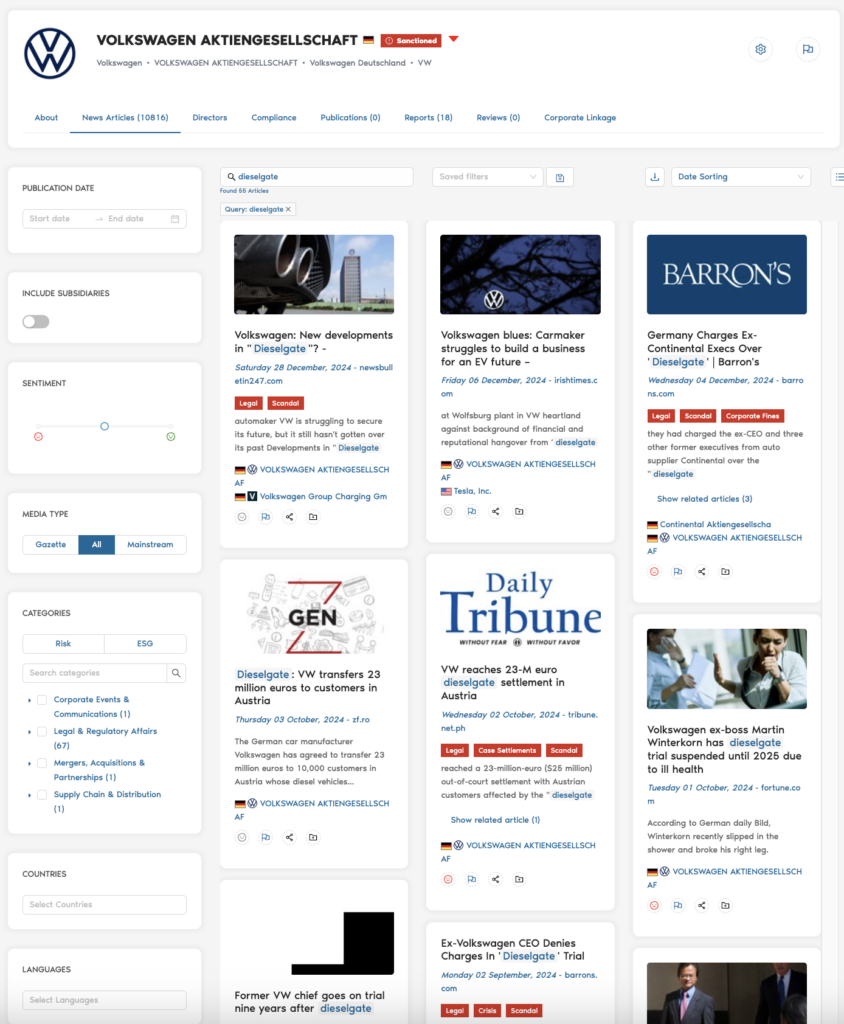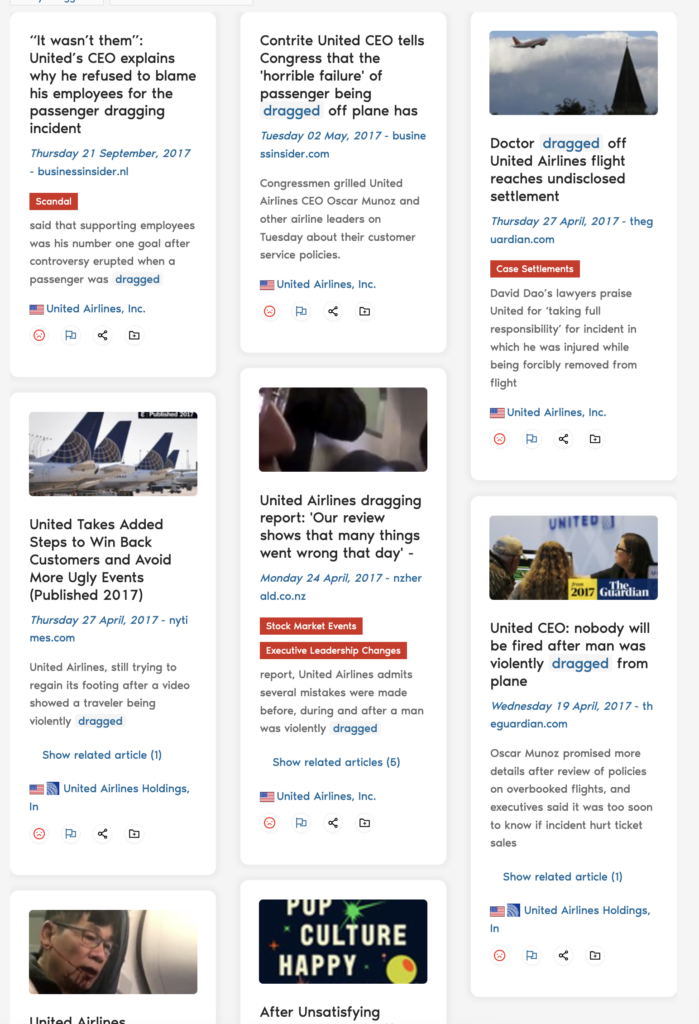What is Adverse Media?
Adverse media is exactly what it sounds like – negative news published across various sources. Research suggests that media reports with negative news catch 30% more attention than non-negative reports. The media prioritizes negative news due to its higher engagement rates.
The idea of a “negativity bias” refers to a phenomenon where humans are inclined to pay more attention to negative information rather than positive. Negative news stories often elicit stronger emotional reactions of outrage, anger or fear. This increases engagement, creating a dopamine economy: a system of business providing instant gratification, and benefiting from the monetization of attention, designed to be addictive. Media algorithms are designed to push content that maintains the most attention and engagement, resulting in a greater presence of negative news. Psychological research also shows that negative events have a stronger psychological impact than positive ones of the same magnitude.
How does adverse media impact my business?
The threat of adverse media on a business can be detrimental. As a business professional, monitoring the adverse media around your business is an integral part of KYB/KYC processes, risk strategies, supply chain monitoring, marketing strategies, brand reputation management and is relevant to almost any industry.
Warren Buffet himself once said “It takes 20 years to build a reputation and five minutes to ruin it. If you think about that, you’ll do things differently”. Plus, the idea of managing your reputation isn’t new, either. Socrates, who lived from 470BCE – 399BC, once said: “Regard your good name as the richest jewel you can possibly be possessed of”.
The question is, how damaging can negative news be for a business? You may have heard of the phrase “All PR is good PR“. But is that really true? Let’s have a look at some famous cases in which adverse media played a significant role:
Volkswagen, 2015

Business Radar: Volkswagen media profile
In 2015, German automobile manufacturer Volkswagen was growing strong with a year-on-year growth of 4-5% annually from 2012 to 2015. In 2014 alone, Volkswagen had sold over 10 million vehicles for the first time. That all changed when the so called “diesel-dupe” scandal came to the news. After extensive media coverage, The Environmental Protection Agency found that many Volkswagen car engines had integrated software that could detect when an emissions test was being conducted, changing the car’s performance to fabricate better results. Later, Volkswagen admitted to selling over 11 million vehicles with the cheating software globally.
Consequences:
- Stock price plummet: From €250 to €92 per share in just six months.
- Reputational damage leading to a 2% decline in annual vehicle sales.
- Multiple government investigations across the world, public outrage and lawsuits.
- Over €30 billion in fines paid globally.
United Airlines, 2017

Business Radar: United Airlines media profiles
In 2017, millions were stunned when a video of a passenger being brutally dragged off an overbooked United Airlines flight in Chicago went viral on social media. David Dao, a 69-year-old Vietnamese American pulmonologist refused to disembark an overbooked flight, claiming he had patients to see the next day. Security officers from the Chicago Department of Aviation violently dragged him off the flight, striking his head against an armrest. Warren Buffet, a major investor in the airline, called United out for making a “terrible mistake“.
Consequences:
- United Continental Holdings stocks, parent company of United Airlines, dropped 6% in one day, wiping out $1 billion in market value.
- Calls for boycotts flooded social media, with many loyal customers posting videos of themselves cutting their United Airlines loyalty and credit cards.
- Reputational damage: 6.8 million views within a day. Number one trending topic on Weibo China and Vietnam, gathering 470 million users’ attention.
- Government investigations.
The airline eventually settled the lawsuit for an undisclosed amount, in addition to paying every customer on board the flight an additional $500. United Airlines also implemented 10 new policy changes.
Although the above examples are extreme and highlight signs of corruption and weak company policies, it is the adverse media aspect that caused the biggest damage. You cannot put a price on reputation, which severely affects customer perception.
How can you understand the media landscape around your business?
Adverse media can be destructive. Whether that be through suffering stock prices, reputational damage or paying substantial amounts for legal settlements – monitoring negative news and being a step ahead is important for risk strategies. Banks, large companies with sophisticated supply chains, conglomerates and consultancies need to monitor up to thousands of companies to ensure avoiding damage through adverse media. Even if it’s not your company, simply doing business with a company known for its adverse media can put into question your company values, standards and ethics. Tools like Business Radar’s Adverse Media Screening Solution continuously monitor your media landscape and alert you of potential risks.
So how can you monitor what the media says about you, your suppliers, partners or investors? And how should you prepare? There are several components to a good adverse media strategy. Let’s analyze what you can do:
- Establish Risk Criteria
- Choose Adverse Media Sources
- Automated Monitoring and Alerts
- Establish an internal response plan
1. Establish Risk Criteria
Establishing the risk indicators most relevant to your business will help in narrowing down your search. Consider your industry, your values and the regulatory requirements you need to meet. Business radar has over 200 predefined risk and ESG categories based on industry standards. Some example indicators include:
| Type | Example Indicators |
| Business risk | Accounting errors, fraud, insolvency, cybercrime |
| Environmental risk | Air quality, pollution, waste management, water shortages |
| Regulatory risk | Corporate governance, money laundering, regulations, sanctions, legislations |
| Social and Labor risk | Child labor, worker safety, employee health and safety, labor practices |
2. Choose Adverse Media Sources
Once the risk criteria have been established, it is time to focus on where the media will come from. Monitoring official lists and unstructured media sources can help in understanding the broader image. Be mindful of the sources you choose – try to avoid sources with a bias. At Business Radar, we exclude any extreme bias articles and include local gazette media in addition to mainstream sources – you can contact us if you want to learn more. Some good starting points are:
- Sanction lists – from official databases and government watchlists:
- OFAC Sanctions List
- Interpol & FBI Lists
- World Bank & IMF
- EU & UK Sanction Lists
- Unstructured adverse media sources: News and media monitoring
- Google News, Bloomberg, BBC, CNN, Reuters
- Stock Exchanges (financial papers and information)
- Gazette and local media, such as Hessischer Rundfunk, which covers local media in Hessen, Germany.
- Industry specific news sources (such as TechCrunch)
3. Automated Monitoring and Alerts
Since timing is limited and scanning the news manually every day is a tedious exercise, you’ll want to set up a monitoring and alerts system. This way, you can ensure to always be updated on relevant events, even when you do not have the time to search the internet yourself. Using Business Radar, you can set up an unlimited number of alerts on your portfolios. Simply choose the risk categories relevant to the respective list of companies and receive news to your inbox on a daily, weekly or monthly basis. Book yourself a free demo to see how it works.
You can also do this manually, though it requires extra steps and can be less accurate. Start by listing the keywords that will help you find the specific information you’re looking for. For example, “McDonalds Controversy” or “Elon Musk Fraud”. Should an adverse situation occur with these keywords, the goal is t be notified right away.
If you are struggling to find the right keywords for your manual search, you can also use SEO tools like Ubersuggest, which provide alternative and related keywords to a specific word. The more extensive your list, the more informed you will be.
You can then customize the frequency at which you want to receive updates. Choose real-time for the most accurate and up to date information. Alternatively, you can also choose between daily, weekly or monthly updates.
For more tech-savvy users, using AI and NLP (Natural Language Processing) tools like AWS Comprehend or Google Cloud NLP can help analyze news sentiments and detect negative keywords in a context. The sentiment analysis can flag adverse media specifically.
4. Establish an internal response plan
Whether you’re monitoring negative news on your own business(es) and its subsidiaries or your partners, suppliers or other stakeholders, you need to know how to react to certain events.
As a company, you can make the best efforts to avoid adverse media being written about you. But an affiliation with another company that is being mentioned in the news can affect your reputation as well. A negative news story can be published at any time, for any reason, and it is difficult to see these stories coming. For this reason, a strong internal response plan should be in place, to be executed upon the discovery of such an article.
Firstly, aim to keep an updated risk assessment and define the levels of severity in the case of an adverse event. Consider the type of damage that can be most detrimental to your company and use the risk criteria established in part 1 to keep an up-to-date risk assessment.
Second, it is useful to have a crisis team at hand in the case of an adverse media event. Assign certain roles and responsibilities and ensure you have at least a team consisting of experts who are trained to handle situations where quick reaction is important. Consider senior leadership roles, PR teams and legal teams, for instance.
Finally, there should be established guidelines on addressing media fallouts with certain protocols in place. Liaise with the crisis team before an adverse media event takes place and discuss certain procedures and protocols.
Monitoring adverse media is important, yet a lengthy process requiring the collection, processing and monitoring of data from multiple sources. At Business Radar, we simplify the process by structuring thousands of daily news articles into one comprehensive solution, allowing you to filter by gazette media, sentiment and more. Business Radar also always avoids extreme-bias publications for the best results. Discover how adverse media monitoring can save time and manage your risk strategy during a free, short demo with our team.